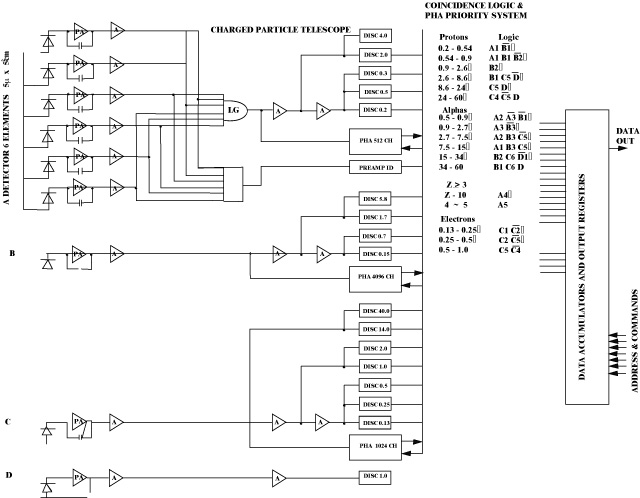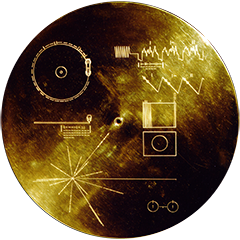VOYAGER
Voyager LECP Data Analysis Handbook
Engineering Design
OPM Weight and Power Estimate
| Weight, grams | Power, mw | |
| Charged Particle Telescope (CPT) | ||
| Detector | 400 | |
| PHA system (4 PHA's including 2 P.A.) | 300 | 425 |
| Preamps (6 low noise + 1 includes shields) | 84 | 320 |
| Amplifiers (16 each @ 17 mw & 3.2 gm) | 51 | 272 |
| Discriminators (17 each @ 10.6 mw & 3.2 gm) | 55 | 182 |
| Logic and priority | 120 | 40 |
| 1010 | 1239 | |
| Power supply & wiring | 250 | @80% |
| 1260 | 1550 | |
| Low Energy Proton Detector (LEPD) | ||
| Detector | 145 | |
| Preamp (1) | 20 | 80 |
| Amplifier (3) | 10 | 51 |
| Discriminator (5) | 16 | 53 |
| Anticoincidence gates | 27 | 10 |
| 218 | 194 | |
| Power supply & wiring | +20 | @80% |
| 238 | 225 | |
| Electron Scatter Detector (ESD) | ||
| Detector | 230 | |
| Preamp | 20 | 80 |
| Amplifiers (3) | 10 | 51 |
| Discriminators (3) | 10 | 32 |
| Anticoincidence gates | 12 | 5 |
| 282 | 168 | |
| 20 | @80% | |
| 302 | 210 | |
| U. of Maryland | ||
| Option A. 4 ADC's with a total of 5 amplifier and discriminator channels | ||
| HV supplies | 1025 | |
| Detector head | ||
| Preamps (10) | 200 | |
| Amplifier (10) | 32 | 170 |
| Discriminator (5) | 16 | 53 |
| PHA (4) | 200 | 320 |
| 1273 | 743 | |
| Power supply & wiring | 75 | @80% |
| 1348 | 930 | |
| Option B. 5 channels for each of 4 detectors | ||
| Detector head | ||
| Preamps (10) | 150 | 200 |
| Amplifier (4 x 3) | 38 | 204 |
| Discriminators (20) | 64 | 212 |
| 252 | 616 | |
| Power supply & wiring | 65 | @80% |
| 770 | ||
| Data System | ||
| CPT - 21 rate limiters and MARS bugs | 120 | 430 |
| LEPD - 5 | 28 | 103 |
| ESD - 3 | 17 | 65 |
| UM (B) - 30 | 114 | 410 |
| CCL | 200 | 280 |
| 479 | 1208 | |
| Power supply | 121 | @80% |
| 600 | 1510 | |
| Summary | ||
| CPT | 1260 | 1550 |
| LEPD | 238 | 225 |
| ESD | 302 | 210 |
| UM | 930 | |
| Data System | 600 | 1510 |
| Structure | 810 | |
| 3210 (7.06 lbs.) |
4425 | |
| Without data system |
2610 |
2915 |
|
(UM) |
1348 |
|
|
3958 |
|
|
Diagram: (Click here for pdf file.)

Next: High Intensity Detector System for the Study of the Magnetospheres of Outer Planets
Return to Voyager
LECP Data Analysis Handbook Table of Contents.
Return to Fundamental
Technologies Home Page.
Updated 8/9/19, Cameron Crane
VOYAGER 1 ELAPSED TIME
--:--:--:--
Days: Hours:
Minutes: Seconds
*Since official launch
September 5, 1977, 12:56:00:00 UTC
*Since official launch
September 5, 1977, 12:56:00:00 UTC
VOYAGER 2 ELAPSED TIME
--:--:--:--
Days: Hours:
Minutes: Seconds
*Since official launch
August 20, 1977, 14:29:00:00 UTC
*Since official launch
August 20, 1977, 14:29:00:00 UTC
QUICK FACTS
Manufacturer:
Voyagers 1 and 2 were built in the Jet Propulsion
Laboratory in Southern California.
Mission Duration: 40+ years have elapsed for both Voyager 1 and Voyager 2 (both are ongoing).
Destination: Their original destinations were Saturn and Jupiter. Their current destination is interstellar space.
Mission Duration: 40+ years have elapsed for both Voyager 1 and Voyager 2 (both are ongoing).
Destination: Their original destinations were Saturn and Jupiter. Their current destination is interstellar space.



